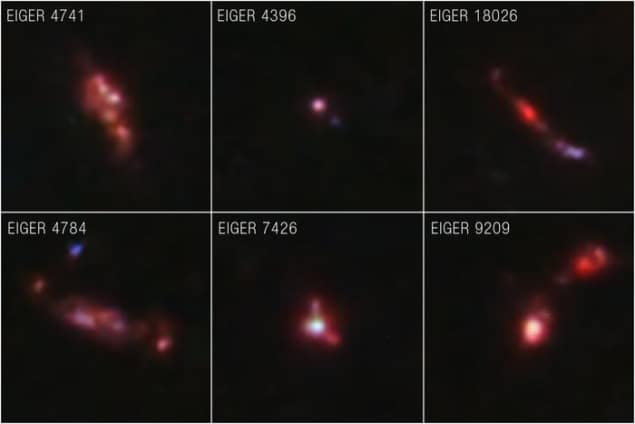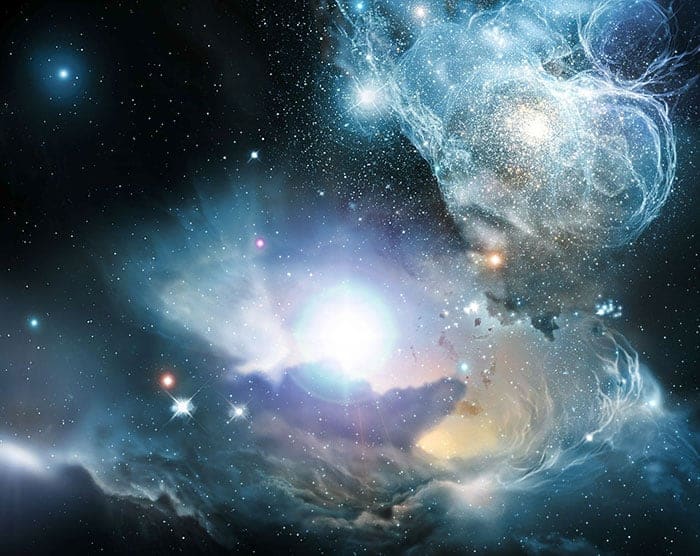
Using the James Webb Space Telescope (JWST), an international team of astronomers has found compelling evidence that early galaxies were responsible for the reionization of the early universe. This is the process by which neutral hydrogen atoms are ionized, making the universe transparent to light at wavelengths that would have been absorbed by the atoms. The research was done by members of the EIGER collaboration, which is using the JWST’s Near Infrared Camera (NIRCam) to study light from quasars in the early universe.
The cosmological era of reionization occurred around a billion years after the Big Bang. Prior to reionization, neutral hydrogen gas between early galaxies absorbed light at certain wavelengths. Then something caused the cosmos to heat up, ionizing the gas to create a plasma. These regions of plasma were less efficient at absorbing light, creating “bubbles†of transparency in the universe.
These bubbles were much larger than the galaxies themselves, with diameters of about 4 million light–years across. Over the hundred million years or so, the bubbles grew and joined together, and eventually the entire universe became transparent. However, exactly what caused this reionization is an important cosmological mystery.
Default explanation
“It was presumably some source of ionizing radiation,†team leader Simon Lilly tell Physics World. “It’s fair to say the default explanation was always that it was ultraviolet light from the first stars and galaxies that formed early in the universe,†explains Lilly, who is based at ETH Zurich in Switzerland. “Some of those stars will be hot enough that they produce a lot of ultraviolet photons, and in principle, that could do it.â€
Other sources of ionizing radiation have also been suggested. These include the generation of ultraviolet radiation and X-rays by the acceleration of material as it falls into black holes.
Now, Lilly and colleagues have studied reionization by using the JWST to observe light from an ancient quasar. This is a supermassive black hole that swallows large amounts of material, causing the emission of huge amounts of radiation. By studying how this light passed through ancient galaxies on its way to Earth, the team discovered a correlation between the locations of these galaxies and the locations of patches of reionized gas. This allowed the researchers to conclude that something within these galaxies, possibly young stars, ionized the surrounding space.
This is the smoking gun, that it was galaxies that did the reionization
Simon Lilly
Lilly together with Daichi Kashino at Japan’s Nagoya University and colleagues describe their findings in a paper in The Astrophysical Journal. This paper is one of three published in that journal related to this research. The second paper is by ETH Zurich scientist Jorryt Matthee and colleagues and looks at the properties of the galaxies, and the third paper looks at the quasar itself and is by Anna-Christina Eilers at the Massachusetts Institute of Technology.
The team will now investigate five other quasars and their lines of sight to Earth in order to further explore the connection between galaxies and reionization.

First stars and galaxies are not as old as we thought, say Planck astronomers
“We’re not the first to discover galaxies at these epochs, and indeed, the JWST is finding galaxies at significantly earlier epochs, but what the telescope really enabled was for us to produce very large, homogeneous samples of galaxies,†Lilly said. “I would have no hesitation in saying we couldn’t have done this without the JWST.â€
For Lilly, who has been associated with the telescope since its early planning stages in the 1990s, this result is an important validation that the JWST is useful beyond taking incredible images of the universe; it has real experimental value too.
“We’re seeing the universe as it was a few 100 million years after the Big Bang, and we’re doing physics there,†Lilly concluded. “We are actually answering questions with the JWST, not just standing in awe of the majesty of the universe.â€


